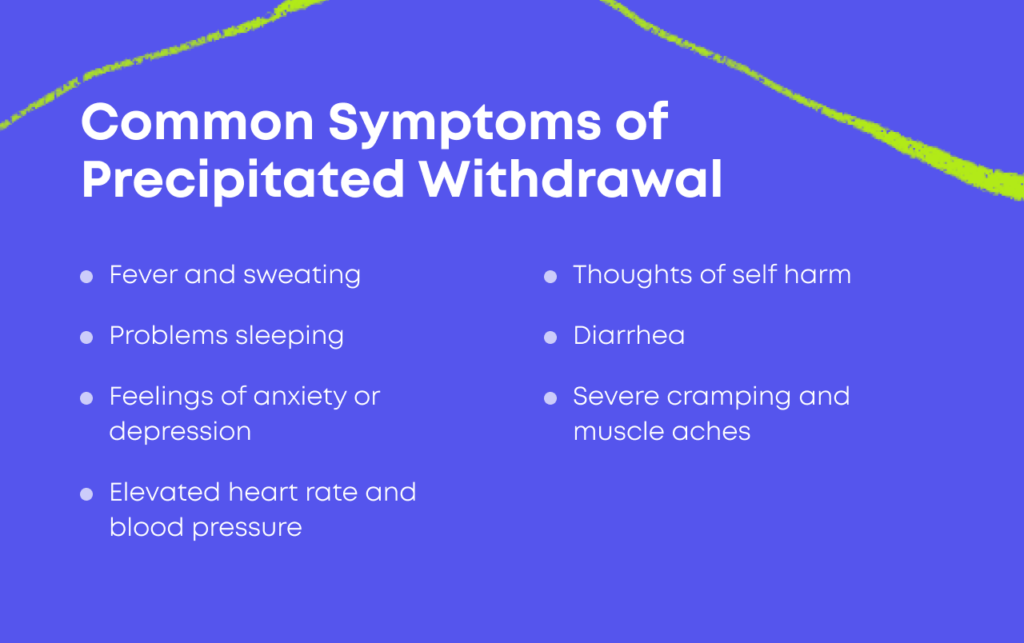Methadone and Suboxone should not be mixed.
Methadone is a full opioid agonist, meaning it strongly turns on opioid receptors in the brain.[1] Suboxone is a partial opioid agonist, which means it partially turns on those same receptors.
However, Suboxone binds more strongly to receptors in the brain than methadone.[2] This means that if Suboxone and methadone are mixed, Suboxone will kick methadone off the opioid receptors in the brain. This will cause precipitated withdrawal.
In rare cases, combining Suboxone and methadone can lead to heart rhythm issues, which could be potentially fatal.[3]
What Is Precipitated Withdrawal?
Precipitated withdrawal occurs when withdrawal symptoms are triggered by medications. Since Suboxone (buprenorphine/naloxone) bumps methadone and other full opioid agonists from the brain’s receptors, it triggers withdrawal.

Because Suboxone produces a reduced opioid response, the body is abruptly thrown into withdrawal when methadone is bumped off the receptors. Studies show that taking Suboxone, particularly at high levels, can precipitate withdrawal in those on methadone.[4]
Symptoms of precipitated withdrawal include the following:
- Fever
- Severe cramping
- Muscle aches
- Sleep issues
- Irritability
- Sweating
- Depression
- Elevated heart rate and blood pressure
- Diarrhea
- Anxiety
- Thoughts of self-harm
Is It Better to Take Suboxone or Methadone for OUD?
Both Suboxone and methadone can effectively be used to manage opioid use disorder (OUD). Suboxone is preferred by most physicians and addiction treatment specialists due to its lower misuse potential.
Suboxone is also often preferred by most patients because of its greater accessibility and ease of use compared to methadone. Since methadone isn’t available via take-home prescription, patients must visit a methadone clinic daily to get their dose. Suboxone, in contrast, can be taken at home.
Buprenorphine, the primary ingredient in Suboxone, is viewed as likely safer for patients than methadone.[1] Most patients will be prescribed Suboxone versus methadone, but the choice will be made on an individual basis depending on each patient’s individual factors, including the severity of OUD, overall health, and life circumstances.
How to Transition From Methadone to Suboxone
If you have been taking methadone to manage OUD and want to switch to Suboxone, talk to your doctor about how best to proceed. They will likely recommend that you wait at least 24-48 hours after last taking methadone before you take Suboxone.[5,6]
Do not attempt to switch from methadone to Suboxone without medical supervision. Your treatment team will be able to help you avoid precipitated withdrawal and make the process more comfortable.[7] They may employ various techniques to ensure you stay safe and supported during the transition.[8]
Sources
- Buprenorphine vs. Methadone Treatment: A Review of Evidence in Both Developed and Developing Worlds. Journal of Neurosciences in Rural Practice. https://www.ncbi.nlm.nih.gov/pmc/articles/PMC3271614/. January–April 2012. Accessed July 2022.
- What Is Buprenorphine? University of Arkansas for Medical Sciences. https://psychiatry.uams.edu/clinical-care/cast/buprenorphine/. Accessed July 2022.
- Drug Interactions Between Methadone and Suboxone. Drugs.com. https://www.drugs.com/drug-interactions/methadone-with-suboxone-1578-0-439-2040.html. Accessed July 2022.
- Sublingual Buprenorphine/Naloxone Precipitated Withdrawal in Subjects Maintained on 100 mg of Daily Methadone. Drug and Alcohol Dependence. https://www.ncbi.nlm.nih.gov/pmc/articles/PMC2094723/. May 2007. Accessed July 2022.
- Transferring Patients From Methadone to Buprenorphine: The Feasibility and Evaluation of Practice Guidelines. Journal of Addiction Medicine. https://www.ncbi.nlm.nih.gov/pmc/articles/PMC5976217/. May–June 2018. Accessed July 2022.
- Pharmacological and Behavioral Treatment of Opioid Use Disorder. Psychiatric Research & Clinical Practice. https://prcp.psychiatryonline.org/doi/full/10.1176/appi.prcp.20180006. April 2019. Accessed July 2022.
- Transition From Full Mu Opioid Agonists to Buprenorphine in Opioid Dependent Patients — A Critical Review. Frontiers in Pharmacology. https://www.frontiersin.org/articles/10.3389/fphar.2021.718811/full. November 2021. Accessed July 2022.
- Transitioning Hospitalized Patients With Opioid Use Disorder From Methadone to Buprenorphine Without a Period of Opioid Abstinence Using a Microdosing Protocol. Pharmacotherapy. https://accpjournals.onlinelibrary.wiley.com/doi/10.1002/phar.2313. July 2019. Accessed July 2022.

Medically Reviewed By Elena Hill, MD, MPH
Elena Hill, MD; MPH received her MD and Masters of Public Health degrees at Tufts Medical School and completed her family medicine residency at Boston Medical Center. She is currently an attending physician at Bronxcare Health Systems in the Bronx, NY where ... Read More
Download Our Free Program Guide
Learn about our program, its effectiveness and what to expect
Related Content
Imagine what’s possible on the other side of opioid use disorder.
Our science-backed approach boasts 95% of patients reporting no withdrawal symptoms at 7 days. We can help you achieve easier days and a happier future.
